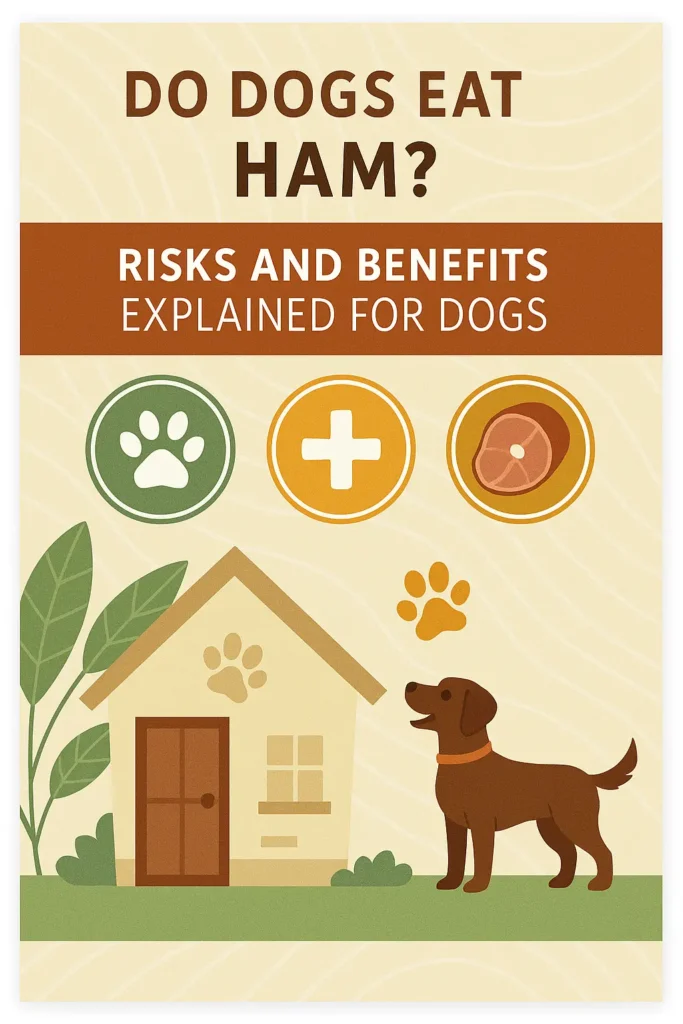Ever caught your dog giving you those puppy eyes while you eat ham? Many pet owners ask, “Do dogs eat ham?” and wonder if it is safe for their furry friends. Ham is a salty meat with high fat and sodium that can lead to health problems for dogs.
This article explains when ham is a safe treat and when it may cause issues. It answers common follow-up questions about symptoms and proper feeding practices. Read on to learn more.

Can Dogs Eat Ham?
Dogs do eat ham, but it is not their best option. Plain, cooked ham in very small amounts rarely harms most pets when given as an occasional treat. A little piece now and then is acceptable. Watch your dog afterward to see if any unusual defecation or discomfort appears.
Ham offers protein that supports muscle building. Still, it carries loads of salt and fat that can cause problems. Many holiday hams include extra spices, glazes, or seasonings that might upset a dog’s stomach or even prove toxic.
For dogs showing signs of pancreatitis or inflammation of the pancreas, care is needed.
Your dog’s size matters. A larger pet may handle a small bite better than a tiny pup, particularly when considering puppy nutrition and overall dog health. DoDogsEat.com notes that each dog is one of a kind – some may have food allergies or health issues that make ham unsuitable.
Safe Serving Guidelines:
- Small breeds: less than 1 ounce per treat
- Medium breeds: up to 2 ounces per treat
- Large breeds: up to 3 ounces per treat
If you share ham with your pet, remove the fatty parts and never feed ham bones, which can splinter and cause choking or cuts in a dog’s mouth or gut. Stay alert for any signs of distress; in a crisis, knowing the basics of the heimlich maneuver might prove useful.
Risks of Feeding Ham to Dogs
Ham has notable risks when given to your pet. The high sodium content can trigger extreme thirst and, in worse cases, salt poisoning. Most store-bought hams contain around 1,200 mg of sodium in a 3-ounce serving, which overwhelms a dog’s system.
This overload forces kidneys to work extra hard. It might lead to vomiting, diarrhea, and fatigue. The rich fat content is another concern. Dogs may show signs such as stomach pain, loss of appetite, or an odd posture that signals discomfort.
Processed ham includes nitrates and nitrites used to preserve the meat. These chemicals may harm your pet over time. Ham bones add another risk.
Excess fat from ham contributes to weight gain, obesity, and joint stress. Over time, this can shorten a dog’s lifespan. Many pets cannot digest such rich food properly. If you spot signs like changes in defecation or abdominal pain, consult your vet right away.
The guide now also explores the few benefits of feeding ham in very limited amounts.
Benefits of Feeding Ham to Dogs
Small amounts of plain ham present a few upsides. Ham supplies protein that aids in muscle development and can serve as a high-value reward during training sessions. Some pet owners report that a tiny ham piece motivates their dog better than standard dog treats.
This meat includes some B vitamins that boost energy levels. It also offers moisture for dogs who do not drink enough water. Keep in mind that these advantages only apply to plain, unprocessed ham given sparingly.
Comparison with Other Protein Sources
Other protein sources often provide safer and more nutritious benefits. Plain chicken and lean meats come with lower fat and sodium than processed ham. Consider these points:
- Plain chicken receives widespread support from veterinary advice.
- Lean meats supply essential protein with reduced health risks.
- Unprocessed ham might serve better than holiday ham with extra seasonings.
Nutritional Breakdown
A 100g serving of cured ham packs 139 calories, 32g protein, 7.4g fat, and a whopping 1,420mg sodium. This amount goes well over AAFCO’s limits for adult dogs, and one serving can hit nearly 710% of a dog’s daily sodium allowance .
Check out the table below for a snapshot of how ham compares with a popular dog food option:
| Nutrient | Ham (100g) | Kirkland Adult Dog Chicken (per cup) |
| Protein | 32g | 26g |
| Fat | 7.4g | 16g |
| Sodium | 1,420mg | 200mg |
| Calories | 202 | 393 |
Digestibility and Safety Insights
Ham’s digestibility can be hit or miss. Some studies show that ham is gentle on a dog’s tummy when given in small amounts, while other research points out that lean poultry is absorbed better.
A few vets even suggest pairing a tiny ham treat with probiotics to help a dog process it more easily.
A dog’s system can have a hard time with a sudden load of salty, fatty food. This can bring up issues like pancreatitis and kidney strain. USDA data reveals that ham’s sodium content ranges from 550 to 1,400mg per serving, so a quick look at the label goes a long way.
Conclusion
Ham treats carry both risks and rewards for your pet. Small pieces of plain, low-sodium ham can work as an occasional treat. Excess ham may bring tummy troubles, weight gain, or worsen health issues. Dogs with underlying conditions or those on specialized dog foods should use extra care.
Always consult your vet before introducing new items into your dog’s diet. A pet’s well-being matters first, so pick foods that support overall dog health. Use ham sparingly rather than as a regular meal.
Learn more about what your four-legged friend can eat by checking our guide on whether dogs can eat cabbage.
About DoDogsEat.com
DoDogsEat.com helps people decide which foods suit their dogs best. We share clear advice on which treats support good dog health with simple, honest language. Various sources guide our insight.
Our lead expert, Dr. Sarah Thompson, DVM, has more than 15 years of experience in pet care and puppy nutrition. Her expertise, along with contributions from other seasoned pet care writers, makes our advice accurate and current.
Every article goes through a careful review that looks at data from respected veterinary journals and verified studies. We break down technical details into friendly, digestible tips for busy pet owners.
We factor in balanced diets, effective dog foods, and clear signs such as changes in defecation to shape our recommendations. Our research is open, and we work hard to keep data clear.
Disclaimer: The content provided is informational and not a substitute for professional veterinarian advice.







